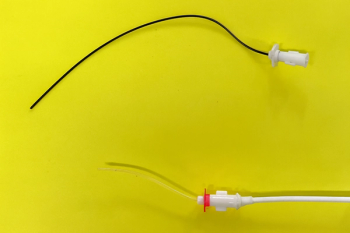
- dvm360 September 2022
- Volume 53
- Issue 9
- Pages: 58
High creatinine levels, low urine output lead to leptospirosis diagnosis

Tinkering with tubules in an acute kidney case
I met Buddy early in my career as a rotating intern and learned a lot from him. Buddy was a Havanese puppy brought to the clinic for not acting normally. His presenting clinical signs were acute onset hyporexia and vomiting en route to the hospital.
Buddy’s initial physical exam was unremarkable, and he appeared to be a happy puppy. His SNAP Parvo Test results were negative, and his radiographs were consistent with a diffuse enteropathy. I prescribed a dose of injectable maropitant citrate (Cerenia), administered subcutaneous fluids, and discharged him. Given Buddy’s presenting physical, I initially was dismissive of his owner’s worry. Three hours later, Buddy returned to the clinic after failing to improve. At this time, he was admitted into the hospital, and hemogram and chemistry panels were submitted.
The hemogram revealed a moderate thrombocytopenia, which I did not confirm with a smear. Chemistry panel revealed a mild elevation in alkaline phosphatase (ALP) and a mild elevation in total bilirubin (0.6 mg/dL; high normal 0.5 mg/dL). Creatinine was elevated at 1.8 mg/dL, which given his vomiting I assumed was prerenal. I went to obtain a cystocentesis urine sample but couldn’t detect his bladder. My second mistake was not being alarmed by the creatinine level. Puppies have low serum creatinine levels; the 1.8 mg/dL was likely a moderate to severe elevation from his normal baseline.
Prior to leaving for the evening, I checked on Buddy and noted that he had not urinated, so I increased his intravenous fluid rate. When I arrived the next morning, I noted that Buddy looked significantly more lethargic and that no urine was noted overnight. A serial chemistry panel revealed a progressive hyperbilirubinemia to 1.8 mg/dL. The creatinine had doubled to 3.3 mg/dL. Both his phosphorus and ALP levels were worse. The most concerning finding was a hyperkalemia of 7.1 mmol/L, which can be an indicator of oliguria or anuria.
Abdominal ultrasound was then performed and revealed mild bilateral renomegaly consistent with an acute kidney injury. Given Buddy’s young age, azotemia, and hyperbilirubinemia, I prioritized leptospirosis. At this point, the team escalated Buddy’s care by placing a central line and urinary catheter. The team administered a fluid bolus and dose of furosemide with no resultant urine production. Given the oliguria and anuria, at this point dialysis was recommended and elected by the client. Unfortunately, because of his small size, Buddy was not a candidate for hemodialysis. Peritoneal dialysis was elected, but Buddy died 18 hours after therapy was initiated.
If I could go back in time, I would have taken the client’s initial complaint more seriously and been more diligent in interpreting the initial chemistry panel. I also should have reattempted to obtain urine. A persistently small bladder may have triggered a concern for oliguria sooner than the serial chemistry panel.
Leptospirosis is a multisystemic disease that primarily affects the kidneys and liver. It is a tubular disease, and when there is a glomerular component, clinicians will see mild to moderate elevated urine protein to creatinine (UPC) ratios. Severe elevations in UPC should raise concern for other glomerulonephropathies. Glucosuria also may be present, which can be indicative of proximal tubular injury. Prognosis is typically fair to good if caught early and managed appropriately.
In the end, my time with Buddy made me a better doctor and, ultimately, a better internist. I learned to take in all the information at hand before jumping to conclusions, which can have a large impact in complicated medical cases.
Adam Miller, DVM, DACVIM, received his veterinary degree from St George’s University and completed clinical rotations at Cornell University. He then completed an intensive small animal rotating internship in medicine and surgery with VCA in Norwalk, Connecticut, before returning to Cornell University for a 3-year residency in internal medicine. His professional interests include nephrology, gastroenterology, and immune-mediated disease.
Articles in this issue
about 3 years ago
We DO talk about Bruno (and Clifford and Wininger)about 3 years ago
Dream team creates their ideal veterinary clinicabout 3 years ago
The Dilemma: Whom should I hire?about 3 years ago
5 questions to answer if you’re considering practice managementabout 3 years ago
What to know before taking out a loan to purchase a practiceabout 3 years ago
Understanding laparoscopy in veterinary surgeryover 3 years ago
Team building is crucial to a successful practiceover 3 years ago
Managing acral lick dermatitis in caninesover 3 years ago
Island displays human-animal bond at its bestNewsletter
From exam room tips to practice management insights, get trusted veterinary news delivered straight to your inbox—subscribe to dvm360.




